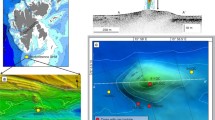Abstract
Naturally occurring gas hydrates, discovered under the deeper parts of the continental margins (generally below 500 m water depth) during the Deep Sea Drilling Project and the Ocean Drilling Program, impregnate terrigenous sediments 0.5 to 1 km thick. They form from biogenic as well as thermogenic hydrocarbon gases and are associated with characteristic chemical and isotopic anomalies in the pore waters resulting from hydrate decomposition. Typical downward trends derived from water samples squeezed on board ship show decreasing chlorinity coupled with increases in the heavy oxygen and hydrogen isotopes resulting from the combined effects of sediment compaction and salt and isotope fractionation by hydrates. Carbon isotopes can be used to differentiate between biogenic (δ 13C < −55‰) and thermogenic (δ 13C > −559‰) gas hydrates except where acetate-derived methane is involved. Smooth downward trends in the chemical and isotopic anomalies suggest steady increases in the proportion of hydrates among the pore-filling substances. Spikes are attributed to high local hydrate concentrations (or massive hydrate layers or nodules). Problems encountered in delineating the detailed relationships between hydrate occurrence and pore-water anomalies concern (i) the roof-effect of a hydrate zone which should be marked by a positive Cl− and a negativeδ 18O anomaly (the opposite of the hydrate decomposition effect) (ii) the composition ofin-situ pore waters from within hydrate zones; (iii) the suppression of a positiveδ 18O hydrate-decomposition anomaly due to superposition of other oxygen-isotope fractionation effects (such as volcanic glass alteration); and (iv) the non-linear correlation between Cl− depletion and18O enrichment, and the magnitude of the18O enrichment. The hydrate-decomposition mechanism still provides the most successful explanation for the chemical and isotopic porewater anomalies observed in hydrate-bearing sediments, but the problems encountered underscore the urgency for future research through deep-sea drilling in hydrate zones.
Similar content being viewed by others
References
S. L. Miller: ‘The nature and occurrence of clathrate hydrates’.Natural Gases in Marine Sediments, Marine Sci. v.3, Ed. I. R. Kaplan, 1974, pp. 151–177.
W. A. Sokolov:Geochemistry of Gases of the Earth's Atmosphere, 301 pp., Nedra, Moscow, 1966 (in Russian).
R. D. Stoll, J. Ewing, and G. B. Bryan:J. Geophys. Res. 76, 2090 (1971).
T. H. Shipley, and B. M. Didyk: ‘The occurence of methane hydrates offshore southern Mexico’. (Init. Repts. Deep Sea Drilling Proj. vol. 66), pp. 547–555. U.S. Govt. Print. Off. 1982.
W. E. Harrison and J. A. Curiale: ‘Gas hydrates in sediments of holes 497 and 498 A, Deep Sea Drilling Project Leg 67’. Init. Repts. Deep Sea Drilling Proj. vol. 67, J. Aubouin, R. von Huene,et al., pp. 591–594. U.S. Govt. Printing Office 1982.
A. G. Yefremova and B. P. Zhizhchenko:Doklady Earth Sci. Sect. 214, 1179 (1974).
K. A. Kvenvolden and L. A. Barnard: ‘Gas hydrates of the Blake Outer Ridge, Site 533, DSDP Leg 76.” Init. Repts. Deep Sea Drilling Proj. vol. 76, R. E. Sheridan, F. M. Gradstein,et al. U.S. Govt. Print. Off. 1983, pp. 353–366.
K. A. Kvenvolden and M. Kastner ‘Gas hydrates of the Peruvian continental margin’ Proc., Ocean Drilling Progr. vol. 112, E. Suess, R. von Huene,et al. (in press).
R. Hesse and W. E. Harrison:Earth Planet. Sci. Lett. 55, 453 (1981).
P. Finley and J. Krason: ‘Formation and stability of gas hydrates of the Middle America Trench’. Geological evolution and analysis of confirmed or suspected gas hydrate localities, vol. 9, Geoexplorers International, 243 pp., U.S. Dept. of Energy, Morgantown, WV 1986.
P. D. Finley and K. L. Dominic:Am. Chem. Soc. Div. Geochem., Abstr. no. 3 1988.
F. T. Manheim and F. L. Sayles: ‘Composition and origin of interstitial waters of marine sediments, based on deep sea drill cores’.Marine Chemistry, The Sea vol. 5, Ed. E. D. Goldberg, Wiley 1974, pp. 527–568.
F. L. Sayles and F. T. Manheim:Geochim. Cosmochim. Acta 39, 103 (1975).
J. M. Gieskes:Ann. Rev. Earth Planet. Sci. 3, 433 (1975).
J. M. Gieskes: ‘Deep Sea drilling interstitial-water studies: Implications for chemical alteration of the ocean crust, Layers I and II’.The Deep Sea Drilling Project: A Decade of Progress, Soc. Econ. Paleontologists Mineralogists Spec. Publ. v.32, Ed. J. E Warme, R. J. Douglas, and E. L. Winterer, 1981.
J. M. Gieskes: ‘The chemistry of interstitial waters of deep-sea sediments: Interpretation of Deep Sea Drilling Data’.Chem. Oceanogr. vol. 8, Ed. J. P. Riley and R. Chester, 1983, pp. 221–269.
R. E. McDuff.Geochim. Cosmochim. Acta 45, 1705 (1981).
R. Hesse: Diagenesis. (Geol. Assoc. Canada, Reprint Ser. v. 4. Ed. I. A. McIlreath) (in press).
R. N. Anderson, M. G. Langseth, and J. G. Sclater:J. Geophys. Res. 82, 3391 (1977).
R. N. Anderson, M. A. Hobart, and M. G. Langseth:Science 204, 828 (1979).
U. Fehn:Econ. Geol. 81, 1396 (1986).
R. D. Hyndman, M. G. Langseth, and R. P. Von Herzen: ‘A review of Deep Sea Drilling Project geothermal measurements through Leg 71’. Init. Repts. Deep Sea Drilling Proj. vol. 78B, R. D. Hyndman, M. H. Salisbury,et al. U.S. Govt. Print. Off. 1985, pp. 813–823.
R. E. McDuff and J. M. Gieskes:Earth Planet. Sci. Lett. 33, (1976).
R. E. McDuff. ‘Conservative behavior of calcium and magnesium in interstitial waters of marine sediments: Identification and interpretation. Unpubl. Ph.D. thesis, Scripps Institution of Oceanography, 183 pp., 1978.
J. R. Lawrence, J. M. Gieskes, and W. S. Broecker:Earth Planet. Sci. Lett. 27, 1 (1975).
J. M. Gieskes and J. R. Lawrence:Geochim. Cosmochim. Acta 45, 1687 (1981).
P. N. Froelich, G. P. Klinkhammer, M. L. Bender, N. A. Luedtke, G. R. Heath, D. Cullen, P. Dauphin, D. Hammond, B. Hartman, and V. Maynard:Geochim. Cosmochim. Acta 43, 1075 (1979).
G. E. Claypool and I. R. Kaplan: ‘The origin and distribution of methane in marine sediments’.Natural Gases in Marine Sediments. Marine Sci. vol. 3, Ed. I. R. Kaplan, Plenum Press, 1974 pp. 99–140.
G. E. Claypool, C. N. Threlkeld, P. N. Mankiewicz, M. Arthur, A. and T. F. Anderson: ‘Isotopic composition of interstitial fluids and origin of methane in slope sediment of the Middle America Trench, Deep Sea Drilling Project Leg 84’. Init. Repts. Deep Sea Drilling Proj. vol. 84, R. Von Huene, J. Aubouin,et al. U.S. Govt. Print. Off. 1985, pp. 683–691.
W. E. Harrison, R. Hesse, and J. M. Gieskes: ‘Relationship between sedimentary facies and interstitial water chemistry in slope, trench, and Cocos plate sites from the Mid-America Trench transect, active margin off Guatamala. Leg 67, DSDP’. Init. Repts. Deep Sea Drilling Proj. vol. 67, J. Aubouin, R. von Huene,et al., U.S. Govt. Print. Off. 1982, pp. 603–614.
R. Hesse, J. Lebel, and J. M. Gieskes: ‘Interstitial water chemistry of gas hydrate bearing sections on the Middle America trench slope, Deep Sea Drilling Project, Leg 84’. Init. Repts. Deep Sea Drilling Project, vol. 84, R. von Huene, J. Aubouin,et al. U.S. Govt. Print. Off. 1985, pp. 727–737.
P. J. Mueller:Geochim. Cosmochim. Acta 41, 765 (1977).
ODP Leg 110 Scientific Party:Nature 326, 785.
J. M. Brooks, M. C. Kennicutt, R. R. Fay, T. J. McDonald, and R. Sassen:Science 225, 409 (1984).
J. M. Brooks, H. B. Cox, W. R. Bryant, M. C. Kennicutt II, R. G. Mann, and T. J. McDonald:Adv. Organ. Geochem. 10, 221 (1986).
J. M. Brooks, M. C. Kennicutt II, R. Bidigare, T. L. Wade, E. N. Powell, G. L. Denoux, R. R. Fay, J. J. Childress, C. R. Fisher, I. Rossman, and G. Boland:Eos. 68, 498 (1987).
J. M. Brooks, M. C. Kennicutt II, and R. C. Pflaum:Am. Chem. Soc. Div. Geochem. Abstr., no. 4 (1988).
M. E. Field and K. A. Kvenvolden:Geology 14, 537 (1986).
M. Schoell:Am. Assoc. Petroleum Geologists Bull. 67, 2225 (1983).
P. D. Jenden and I. R. Kaplan:Appl. Geochem. 1, 631 (1986).
R. K. Suchecki, and L. S. Land:Geochim. Cosmochim. Acta 47, 1487 (1983).
Land, personal communication (1987).
J. Azema, J. Bourgois, P. O. Baumgartner, J. Tournon, A. Desmet, and J. Aubouin: ‘A tectonic cross-section of the Costa Rican Pacific littoral as a key to the structure of the landward slope of the Middle America trench off Guatamala’. Init. Repts. Deep Drilling Proj. vol 84, R. von Huene and J. Aubouin,et al. U.S. Govt. Print. Off. Washington, D.C. 1985, pp. 831–850.
J. M. Gieskes, K. Johnston, and M. Boehm: ‘Interstitial water studies, Leg 66’. Init. Repts. Deep Sea Drilling Proj. vol. 84, R. von Huene, J. Aubouin,et al. U.S. Govt. Print. Off., Washington, D.C. 1985, pp. 961–967.
K. A. Kvenvolden and T. J. McDonald: ‘Gas hydrates of the Middle America Trench’. Init. Repts. Deep Sea Drilling Proj. vol. 84, R von Huene and J. Aubouinet al. U.S. Govt. Print. Off. Washington, D.C. 1985, pp. 667–682.
P. D. Jenden and J. M. Gieskes: ‘Chemical and isotopic composition of interstitial water from Deep Sea Drilling Project sites 533 and 534’. Init. Repts. Deep Sea Drilling Proj. vol. 76, R. E. Sheridan, and F. M. Gradsteinet al. U.S. Govt. Print. Off., Washington, D.C. 1983, pp. 453–461.
R. E McDuff. ‘The chemistry of interstitial waters, Deep Sea Drilling Project Leg 86’. Init. Repts. Deep Sea Drilling Proj. vol. 86, G. R. Heath and L. H. Burckleet al. U.S. Govt. Print. Off., Washington, D. C. 1985, pp. 675–687.
R. von Huene, J. Aubouin, J. Azema, G. Blackinton, J. A. Carter, W. T. Coulbourn, D. S. Cowan, J. A. Curiale, C. A. Dengo, R. W. Faas, W. Harrison, R. Hesse, D. M. Hussong, J. W. Ladd, N. Muzylov, T. Shiki, P. R. Thompson, and J. Westberg:Geol. Soc. Am. Bull. 91, 421 (1980).
‘DSDP Leg 84, Shipboard Scientific Party: Site 565’. Init. Repts. Deep Sea Drilling Proj., vol. 84, R. von Huene and J. Aubouinet al, U.S. Govt. Print. Off. 1985, pp. 21–77.
D. W. Davidson, D. G. Leaist, and R. Hesse:Geochim. Cosmochim. Acta 47, 2293 (1983).
Author information
Authors and Affiliations
Additional information
Dedicated to Dr D. W. Davidson in honor of his great contributions to the sciences of inclusion phenomena.
Rights and permissions
About this article
Cite this article
Hesse, R. Pore-water anomalies in gas hydrate-bearing sediments of the deeper continental margins: Facts and problems. J Incl Phenom Macrocycl Chem 8, 117–138 (1990). https://doi.org/10.1007/BF01131292
Received:
Accepted:
Issue Date:
DOI: https://doi.org/10.1007/BF01131292




